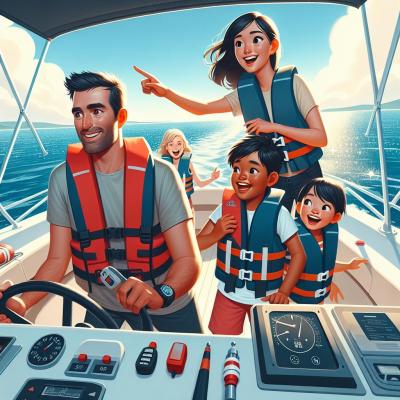Beyond the fun and games, at the heart of family boating lies a crucial aspect that cannot be overlooked - safety. Ensuring that each voyage is safe for all aboard is just as important as making sure it's enjoyable. We'll be diving into essential tips and tricks to keep your little ones secure, while also making sure that their boating experience is nothing short of fun.
As we weigh anchor on this topic, remember that safety begins with preparation and knowledge. Stick with us, and we'll tackle the best practices to make every boating trip with kids a smooth sailing one. Let's embark on this journey together and steer towards mastering the art of fun-filled and safe boating with kids.
Preparing for Your Boating Adventure
Choosing the Right Boat for a Family Excursion
When it comes to boating with kids, the vessel you choose is pivotal to ensuring a safe and enjoyable experience. It's essential to select a boat that's not only reliable but also suited to the needs of your family. Consider the size and stability of the boat, the onboard facilities such as restrooms and shade areas, and whether the vessel is equipped with child-friendly features.
It’s also worthwhile to think about the type of boating you're planning. Are you going on a leisurely lake cruise, river fishing, or an oceanic adventure? Different environments require different boat types, from pontoon boats for calm waters to more robust vessels for the open sea.
Packing Essentials: Safety Gear and Comfort Items
Once you’ve nailed down your ideal boat, it’s time to pack. Safety should always be at the forefront, which means life jackets for all passengers, including specially-designed ones for young children, are a must. Include a first aid kit, sun protection, and plenty of water to keep the family hydrated. Don't forget comfort items either, such as soft clothing, blankets, and favorite toys to help kids feel at home on the water.
It is important to remember that overpacking can be as much of a hindrance as underpacking. Striking a balance is key; ensure you have all you need without cluttering the boat and restricting movement.
Including Educational Opportunities in the Trip Preparation
Boating isn't just an adventure—it’s a learning opportunity for your kids. Engage them in the trip planning to teach them about the route you'll take, and discuss the different aquatic life you might see along the way. Introducing them to basic boating safety and maritime rules can build their awareness and appreciation for the marine environment.
Additionally, you can turn the experience into an interactive game by having kids assist with simple tasks on the boat, creating a fun environment that naturally promotes learning and responsibility.
Essential Safety Measures
Life Jacket 101: Proper Fitting for Children
One of the most crucial aspects of boating safety with children is ensuring they have properly fitted life jackets. It is not just a matter of selecting any life jacket but finding one that is appropriate for the child's weight and size. A well-fitted life jacket should be snug, yet comfortable, with all straps and buckles securely fastened. To test its fit, have your child raise their arms over their head; the jacket should not rise above their chin or ears.
Regularly check life jackets for wear and tear and update them as your children grow. Involve your kids in the process of choosing their jackets—let them pick a design they like, as this will encourage them to wear it without a fuss. Remember, life jackets save lives, but only if they're worn correctly.
Boat Safety Equipment Checklist
Before setting sail, it is essential to ensure your boat is equipped with all the necessary safety equipment. Develop a checklist that includes items such as flares, a horn or whistle, a VHF radio, and a throwable flotation device. Also, make sure you have a fire extinguisher, navigation lights, and an emergency oar or paddle aboard. Having a watertight flashlight and extra batteries can be vital in the event of an emergency after dark.
Remember to check the expiration dates on flares and fire extinguishers regularly and replace any safety equipment that is no longer functional. Every item on your safety checklist is there to protect you and your family in various situations that may arise while on the water.
Navigational Rules of the Water
Understanding the rules of navigation is akin to learning the rules of the road when driving. These rules ensure order and safety on the water. Familiarize yourself with the basic 'road signs' such as buoys and beacons, which provide direction and warn of hazards. Also, learn the 'rules of the road' for meeting, crossing and overtaking other vessels to avoid collisions.
Teach your children some of these basic rules, so they understand the importance of why boats are operated in a certain way. Instilling this knowledge early on promotes safety and can inspire confidence in young boaters. Whether you’re cruising on a serene lake or navigating a busy channel, understanding and abiding by these navigational rules is imperative for the safety of your vessel and your loved ones aboard.
Teaching Kids Boating Safety
Interactive Ways to Teach Children About Boating Safety
When it comes to children, learning through interaction and play can be extremely effective. Turn safety lessons into age-appropriate games, like a scavenger hunt for safety equipment, or a 'captain says' game to practice boating commands. Role-playing different scenarios, such as what to do when someone spots another boat or identifies unsafe practices, can also be beneficial.
The use of colorful charts and engaging stories that encapsulate safety messages leave a lasting impression. Parents and guardians can utilize resources such as safety activity books specifically designed for kids to make the learning process more enjoyable.
The Role of Children in Maintaining a Safe Boating Environment
While on the boat, assign children specific responsibilities according to their age and capabilities. They can be in charge of their own life jacket, help keep the deck free of tripping hazards, or be a lookout for other boats or potential dangers. By giving them responsibilities, they feel included and take safety more seriously.
Involving children in the routine safety checks before departure can also be educational and can foster a sense of accountability. Such engagement also reinforces the idea that safety is a collective effort and that everyone, no matter their age, plays a part.
Emergency Procedures and Communication
Discussing emergency procedures should be a calm and reassuring process, emphasizing the unlikelihood of such events but stressing the importance of being prepared. Teach kids basic emergency signals, how to use a whistle for attracting attention, and the proper way to communicate distress to other boaters or rescue services.
Ensure they know where the VHF radio is and how to call for help if necessary. Practicing man overboard drills and how to stay calm and float if they find themselves in the water can be life-saving skills. Over time, with repeated practice, these procedures can become second nature to young boaters.
Fun Boating Activities for the Whole Family
Engaging Games and Activities to Play on the Boat
Boating offers more than just the thrill of navigation and the serenity of open waters; it's a platform for a host of fun games and activities. Treasure hunts where children search for "buried treasure" hidden on the boat can spark hours of engaged play. Likewise, creative crafts using natural elements found during the boating trip can not only keep little hands busy but also foster their artistic side.
Board and card games are a great way to pass the time when the boat is anchored, and storytelling sessions can capture the imagination of young ones as they create their own sea legends. These activities can help build lasting family memories and are a fantastic way to bond.
Wildlife Watching and Nature Appreciation
Boating allows families to immerse themselves in wildlife and nature's beauty. Equip your children with binoculars and let them marvel at seabirds in flight, dolphins cresting the water's surface, or even the occasional seal basking in the sun. Challenge them to identify different species and keep a logbook of their sightings.
Teach them about the importance of preserving these natural habitats and the role they can play in conservation. Instilling a love for the environment at a young age can create a lifelong passion for the outdoors and conservation efforts.
Fishing with Children: A Beginner's Guide
Fishing can be a tranquil yet exhilarating activity for kids on a boating trip. Start with simple, child-friendly equipment, and practice casting in open water. Demonstrate the basics of baiting hooks and talk about the patience required for fishing. Celebrate every catch your child makes, no matter the size, to build their confidence and interest in the activity.
Also, emphasize catch and release practices, explaining why it's important to respect and preserve marine life populations. This not only teaches them about fishing but also imparts valuable lessons on responsibility and stewardship of the environment.
Maintenance and Post-Trip Care
Clean-up and Boat Maintenance as a Family Activity
A successful boating adventure doesn't end as soon as the boat docks; it's followed by the essential task of clean-up and maintenance. Instead of approaching this as a chore, involve the entire family to teach responsibility and teamwork. Assign age-appropriate tasks for each family member, like disposing of trash, wiping down surfaces, or helping with the cover. Explain how these actions ensure the boat remains in good condition for future outings.
Engaging kids in maintenance can also lead to a deeper understanding and appreciation of the vessel. Plus, by working together, you can have the job done more quickly and efficiently, leaving more time for family bonding post-trip.
Teaching Children About the Importance of Caring for the Environment
Post-trip care also includes consideration of the marine environment. Use this time to educate your kids on why it's vital to leave the waters as clean as— or cleaner than— they found them. Discuss the impact of littering and pollution, and make sure any waste produced onboard is disposed of properly on land. Instilling these values early on fosters environmentally conscious behavior that extends beyond boating activities.
Highlight the connection between well-maintained boats and a clean environment; leaks or spills from poorly maintained vessels can harm aquatic ecosystems. This holistic approach to the health of the boat and the surrounding environment can make children mindful boaters for life.
Storing Equipment and Preserving Memories
After the cleaning and maintenance are complete, storing boating equipment properly is important. Show your children where everything belongs and why it's necessary to keep gear in good condition. For instance, life jackets should be dry before storage to prevent mildew, and fishing tackle needs to be neatly organized for easy access next time.
Lastly, encapsulate the day's experiences by creating a memory book or a digital album with your children. Include photos, drawings, or notes about the day's journey. These memories serve as a treasure trove for the family and provide a narrative of shared adventures and lessons learned that can be revisited for years to come.
Creating Lasting Memories and Future Seafarers
As we drop anchor on our discussion about family boating, it's clear that the waves we navigate can teach us much about adventure, nature, and ourselves. Each voyage offers a fresh horizon of experiences that can color our lives with vibrant memories. Engaging in boating as a family not only fortifies bonds but also galvanizes a legacy of respect and love for the aquatic realm.
Boating with children is about more than leisure; it's about cultivating future seafarers who are as comfortable with the helm as they are with the idea of conservation. With every shared sunset and spotted constellation, a tradition sails into the future, passed from one generation to the next, fostering an enduring love for the open water.
To build upon these traditions, we extend an open invitation to you, our readers, to share your own stories and experiences. What have been your most unforgettable moments while boating with kids? How have you approached teaching them the ropes—both literal and figurative? By contributing your tales, you help enrich our collective knowledge and kindle a spirit of community among fellow boating enthusiasts.
We encourage you and your family to continue exploring the vast blue, to keep learning from each journey, and to always navigate with a sense of wonder. May the memories you create aboard your vessel be as infinite as the stars above and as deep as the waters below. Thank you for joining us on this adventure. Safe travels, and may fair winds always fill your sails.
Last updated: Sunday 7th January, 2024









